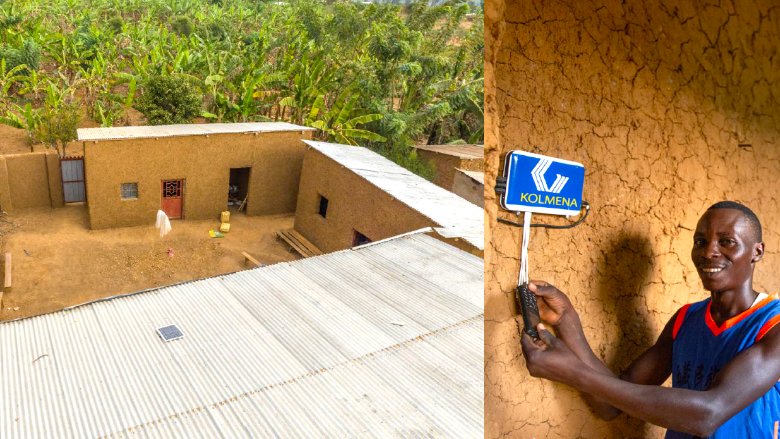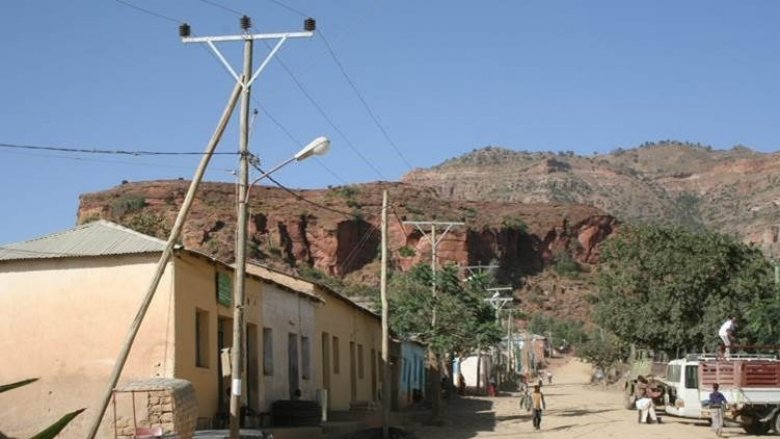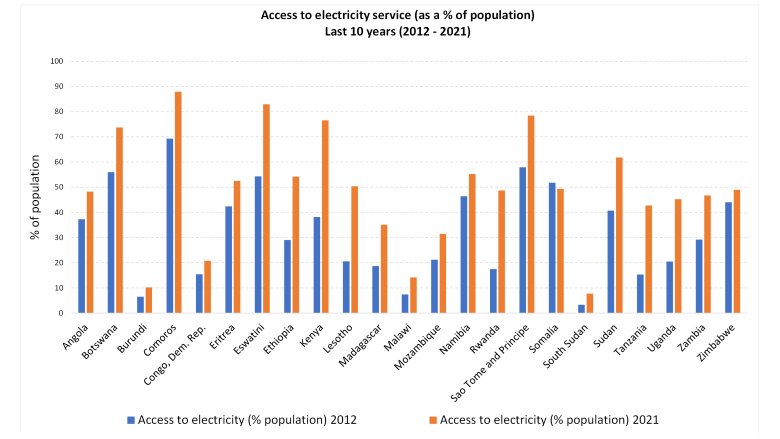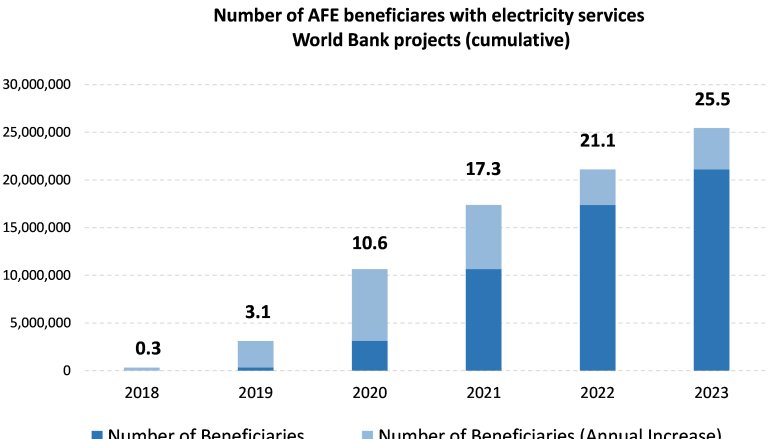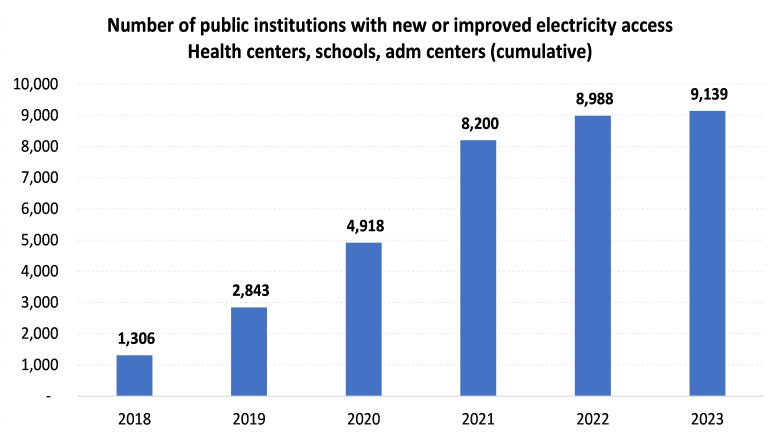HIGHLIGHTS
- 25 million people in Eastern and Southern Africa gained new or improved electricity access from FY18 to FY23.
- Between 2016 and 2023, Uganda saw an increase in electricity access for 8.8 million individuals.
- 6 million people gained access to electricity in Tanzania across two IDA cycles since 2020.
- 1.7 million people benefiting from ProEnergia project in Mozambique since 2019.
- Since 2016, new on-grid electricity services have been provided to almost 4.7 million people in Ethiopia.
- Since 2016, 1.2 million people have gained access to off-grid solar electricity in Rwanda.
- 173,000 new grid connections in Malawi since 2020.
SYNOPSIS
The Eastern and Southern Africa (AFE) region has vast untapped renewable energy resources; however, a large number of people, communities, and public facilities do not have access to electricity, and clean cooking solutions, imposing limits on education, gender equity, economic growth, and development. The World Bank’s energy strategy in the region expands access to electricity via grid or off-grid solutions, following least-cost electrification pathways adapted to country contexts. It also mobilizes private sector investment for on-grid clean energy generation and for distributed renewable energy technologies. On clean cooking, the Bank is capitalizing on the lessons learned from the off-grid solar sector to stimulate market forces to deliver results. The Bank supports governments in building capacity, improving the regulatory and financial enabling environment, enhancing the performance of national utilities, and with investments aimed to increase energy access levels as well as the reliability and affordability of electricity supply and create strong pipeline of clean cooking solutions. Within this framework, the World Bank’s strategy in the AFE region aims to unlock private sector investments and engage public, private and multilateral partners with the ultimate goal of achieving universal energy access by 2030.
For further information of how we are currently ramping up access to electricity in Africa, visit: Energizing Africa
CHALLENGE
Untapped Potential
Eastern Africa is a region with vast untapped energy resources, including hydro, geothermal, wind, and solar power, which could be harnessed to support economic growth and development. However, the region faces significant challenges in attracting investment - including political instability, weak governance, inadequate regulatory frameworks, and insufficient financing. The development of energy infrastructure requires a long-term vision and strategic planning, involving stakeholders from the public and private sectors, as well as local communities and civil society organizations.
In 2021, only 48 percent of the total population in AFE countries had access to electricity services, with rural areas experiencing the lowest penetration at just 33 percent. In low-income countries such as Burundi, Malawi, and Democratic Republic of Congo, less than 21 percent of people have access to electricity.
Moreover, the low-carbon energy transition will trigger a substantial demand for resources across Africa, with the Sub-Saharan region requiring an estimated 3 billion tons of minerals and metals by 2050 to support the deployment of solar, wind, and geothermal energy. Diversifying investments in renewable energy will be crucial for the low-carbon transition. Historically, most renewable energy investments in Sub-Saharan Africa (SSA) have come from the public sector, in contrast with the global share of publicly funded renewable energy investments, which stands at just 14 percent.
APPROACH
An Ambitious Energy Access Target
United Nations Sustainable Development Goal (SDG) 7 calls for “affordable, reliable, sustainable, and modern energy for all” by 2030; achieving universal electricity access by 2030 is a World Bank priority for the AFE region. To steer the path towards SDG7, the Bank has set an intermediate target of doubling the pace of access expansion by scaling up successful country-based access programs, unlocking private sector involvement, and leveraging distributed renewable energy between now and 2026. This initiative aligns with broader goals related to climate action, food security, and human capital development.
A strategic framework has been developed for expanding energy access with the International Development Association’s (IDA) IDA20 and IDA21 replenishments in the AFE region to scale up grid and off-grid electricity connections in line with the region’s objective of accelerating the pace of electrification pace. The approach is based on mobilizing funding, capacity, and partnerships, including tapping into private sector capital, by (i) scaling up grid, off-grid, mini-grid, and clean cooking access via a large horizontal “Accelerating Sustainable and Clean Energy Access Transformation in Eastern and Southern Africa” Multi-Phase Approach (ASCENT MPA), with delivery planned for FY24; (ii) implementing reforms and investments aimed at ensuring reliability, affordability and sustainability of electricity supply over the medium term, (iii) strengthening implementation capacity through Electrifying Africa Programmatic Advisory Services and Analytics (PASA) and (iv) leveraging World Bank-wide collaboration to foster private sector engagement via the Distributed Access with Renewable Energy Scale Up (DARES) Platform.
The Energy Sector Management Assistance Program (ESMAP) has played a key role in advancing energy access in Eastern and Southern Africa, and will support the achievement of this agenda. ESMAP, a partnership between the World Bank and more than 20 development partners to help low and middle-income countries reduce poverty and boost growth through sustainable energy solutions, supports the region through two critical workstreams. First, through its own-managed work, ESMAP advances innovative approaches regarding technology use, business models, financial instruments, subsidy schemes, and more, and facilitates knowledge dissemination within the World Bank and beyond. Second, ESMAP provides key technical support to inform lending operations via Bank-Executed Trust Funds on innovative technology streams such as mini grids and off-grid solutions, and on cross-cutting topics that include electrification of public facilities, productive uses of electricity, and gender.
Through this multi-pronged approach, ESMAP has been able to respond quickly and flexibly to the evolving needs and priorities of client countries and technical teams in Eastern and Southern Africa. To increase the pace of electrification in Eastern and Southern Africa, ESMAP will support the ASCENT MPA and the DARES platform by advancing innovative approaches through its own-managed work. It will coordinate the ASCENT MPA and the DARES platform through the Electrifying Africa PASA, which will be located within ESMAP with the goal of providing complementary technical assistance platform to support the implementation of the World Bank’s enhanced energy access agenda. While the focus of Electrifying Africa is on electrification, the facility will also actively explore synergies with clean cooking.
